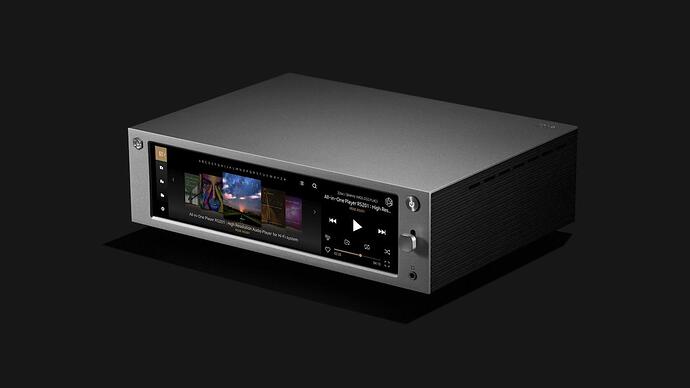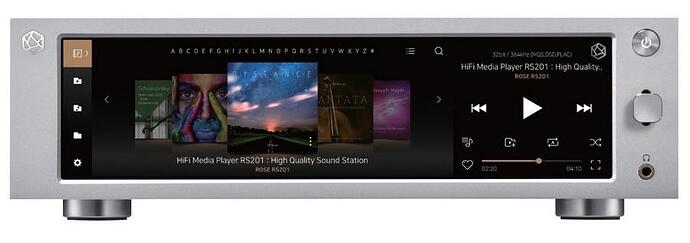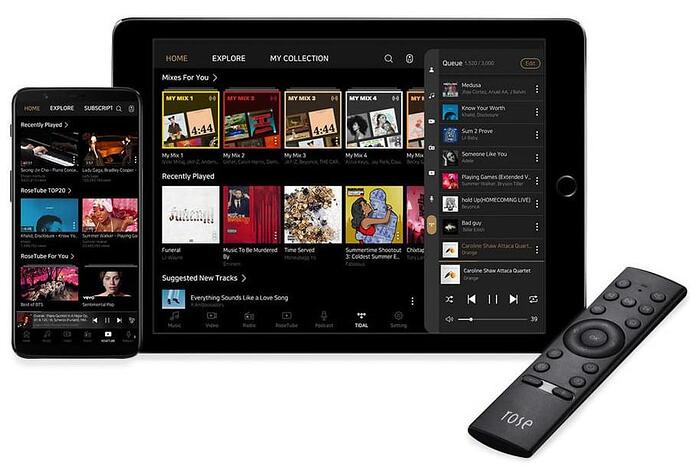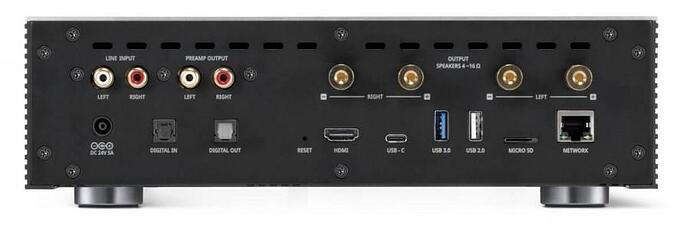DIGITAL MUSIC SYSTEMS
URL : HiFi Rose RS201E Media Player Review - ecoustics.com
HiFi Rose RS201E Media Player Review
The HiFi Rose RS201E Media Player offers both high-resolution audio and video in a category with a lot of compelling options.
![]()
By Ian White Published February 18, 2021
Do you mind moving your elbow?
The network media player category is getting rather crowded. If we were at a cocktail party, one would have to use their elbows to make some space. Fortunately, I have “Gordie Howe” elbows and I’m going to make some room for the HiFi Rose RS201E. HiFi Rose have priced their media player ($1,700 USD) right smack in the middle of this category; flanked on one end by the Bluesound PowerNode 2i, Cambridge Audio CXN V2, and on the other side by the Naim Uniti Atom.
The HiFi Rose RS201E has to offer a lot of performance, features, and connectivity options to be competitive in this space – and for the most part it succeeds quite well at all 3 tasks.
You can read all of the technical details below at the bottom of the review, but a few items really stand out. No hard boiled eggs.
Its ability to stream and play back video will be of obvious value for people who want an easy way to connect a media player to a HDTV. It’s very easy to run a HDMI cable and one set of loudspeaker cables from the RS201E to a television and pair of loudspeakers and you’re done.
The unit demonstrated superb Wi-Fi stability in a home filled with wireless devices that are always competing for bandwidth. That might sound trivial, but I’ve reviewed far more expensive media streaming devices that struggled with such a task.
The touch screen responded without fail to every request, and there was never any form of lag. We’ve become accustomed to swiping our fingers across mobile devices and accessing the media that we want without delay. The RS201E doesn’t have the slickness of an Apple device but it’s rather easy to use and it required very little effort to dig deeper into the various menus and learn how to switch from powered media player to media streamer, or to find new content.
The “McIntosh” blue meter option is certainly a nice touch and show of respect for the venerable brand from Binghamton.
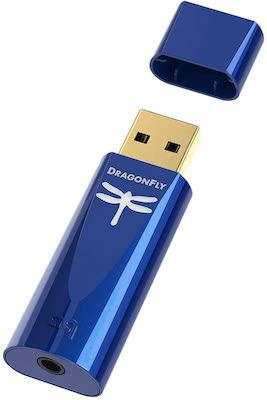
Audioquest Dragonfly Cobalt DAC
I connected 3 USB DACs to the RS201E and it recognized each of them right away; zero compatibility issues. The AudioQuest DragonFly DACs worked especially well with the unit.
During the review process, the unit notified me 4 times about firmware updates and all one needed to do was touch the screen and accept the request.
The latest firmware update introduced Qobuz to the platform and not a moment too soon. I’ve always been able to stream Qobuz using AirPlay from my iPhone, but there was never native support for the app until now.
Gapless playback of Tidal and Qobuz is a huge win here.
I have three nitpicks with the RS201E that I must address.
There is a fiddly volume toggle on the right side of the front panel. I’m still not sure why it exists; there is both a supplied remote control and control app to accomplish that task and I would be really concerned if the end user lost both the remote and their phone.
There are a number of apps designed for Korean users that you can’t really use here in N. America. You can dig into the menus and remove the icons from the front panel options; and reset them for the United State if you’re interested in listening to the podcasts that are already supported.
My biggest nitpick is with the Rose Connect control app. It’s clunky to operate and it definitely needs some refinement in regard to how it integrates the various streaming services.
Control apps need to be easy to navigate and not offer options that you’ll never use. It’s definitely useable but other platforms like Bluesound’s BluOS are way ahead in that regard.
Nu? How does it sound?
I did this review in reverse order. No…I’ve not been drinking. Bloody puritans.
The RS201E arrived at the same time as a selection of USB DACs and it just seemed like the thing to do.
The decision to include both USB and S/PDIF digital outputs was the smart choice with the RS201E because many users are going to consider connecting the media player to an external DAC, A/V receiver, or active loudspeakers with digital inputs.
The AudioQuest DragonFly Cobalt was recognised immediately and all I had to do was connect a 3.5mm to RCA cable from the DAC to the Yamaha A-S3200 integrated amplifier and we had music.
A lot of music.
My first thought was that the RS201E was quite bold sounding; soundstage was deep and wide, tonal balance was rich, and the presentation was definitely not laid back sounding.
But was I listening to the sound of the DAC, amplifier, or the media player?
The Cobalt is not an aggressive sounding DAC, so I wondered if the RS201E was actually on the more neutral side with a decent degree of pace — and just benefitting from the extra midrange warmth of the AQ DAC.
Out went the DAC. The media player has both pre-outs and 1 pair of line outputs so it was easy to utilise the RS201E’s 32-bit/384kHz (with native support for DSD 256) DAC and run it directly into the Yamaha, NAD C 316BEE V2, and Cambridge Audio AXA35 integrated amplifiers.
Listening to electronica from Aphex Twin, Kraftwerk, and Brian Eno made it clear that the RS201E is not afraid of complex music, can stream music with some pace, and can extract detail if it exists.
Vocals conveyed a more neutral presentation that never crossed the line into the analytical camp, but nobody is going to confuse the RS201E with a tube amplifier.
Sarah Vaughn, Jason Isbell, Sam Cooke, and Nick Cave were all front and center; clear, coherent, and with ample detail. Adding a DAC like the Cambridge Audio DacMagic 200M or AQ Cobalt changed the tonal balance in a significant way; every vocalist had greater resolution, detail, and sounded far more fleshed out. More human.
If you’re looking for a media player (using its internal power amplifier) that has deep, and punchy bass — the RS201E falls a little flat in that regard. This is definitely one of the reasons why I preferred its performance as just a media player connected to another DAC or amplifier.
When connected to the Yamaha A-S3200, the bass was deep, resolute, and had far more meat on the bones.
All three integrated amplifiers were a good match sonically the RS201E; the NAD was a better match with the DragonFly Cobalt in the mix.
Not the only game in town…
So how does the HiFi Rose RS201E compare to its competition?
People who desire a single box and a pair of loudspeakers will find my kvetching here a tad neurotic, but it’s more a point about cost/performance.
For the price of a single RS201E, one could assemble a number of different combinations that might offer superior sound quality/functionality.
The Bluesound PowerNode 2i doesn’t offer a fancy touch screen, or the ability to stream 4K video to your HDTV, but it does almost everything else for less money. Neither unit comes equipped with a phono pre-amplifier so that needs to be considered if you are looking for a one-box solution that does everything.
The PowerNode 2i has a more robust sound, but it may be too warm sounding for some. The RS201E is far more neutral sounding when used as an amplifier.
We are a big Wharfedale family (Diamond 10.1s, Diamond 12.1s) and I absolutely loved both combinations. The Diamond 12.1 loudspeakers liked the control, and tonal balance of the RS201E; the combination would make a superb desktop or bedroom system.
One could also create a system around the NAD C 316BEE V2 and the Bluesound Node 2i for less money as well and that includes a very impressive MM phono stage as well.
Once again – multiple boxes, extra cables, no touch screen, video streaming, or pre-amp out option.
On the other end of the spectrum, the Naim Uniti Atom is the Rolls Royce of the category for $3,200 and it offers a level of industrial design and functionality that none of the media network players in the category can presently touch. It may not be the most powerful amplifier, but the Uniti Atom makes sense for a lot of reasons. Matched with the right loudspeaker, the Naim network amplifier delivers a great experience.
The HiFi Rose RS201E’s on-screen interface is one of its strongest features and it was not far behind the Naim in that regard. Album art when streaming from Tidal or Qobuz looked quite impressive on the wider screen.
A Rose in Bloom or a Wilted Flower?
Aside from some operational quirks, the HiFi Rose RS201E media player was a rather surprising and fun component to review. It is not the most powerful amplifier that I’ve ever tried, but paired with the right loudspeakers it can deliver a lot of music on your desktop or in a smaller room. The value proposition changes when used solely as a media streamer and with an external DAC if that methodology floats your boat. Throw in support for DSD and MQA, and you have a rather comprehensive media player that is constantly being updated with new podcast channels, streaming platforms, and internet radio stations.
Connected to the $7,500 Yamaha A-S3200 integrated amplifier, the HiFi Rose RS201E demonstrated its capabilities as a first-rate source device that was easy to use, and not out place with far more expensive components.
The touch panel proved to be one of its best features, and the recent firmware update delivered native Qobuz support — a feature that was badly needed.
It does face some stiff competition in the category, and the control app needs some refinement, but it’s definitely one to take for a spin if you’re looking for a one-box solution that takes up very little space and sounds great in the process.
For more information: HiFi Rose RS201E Media Player

